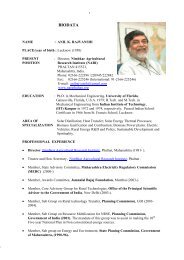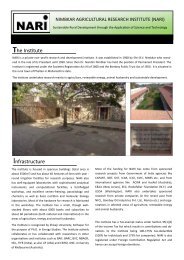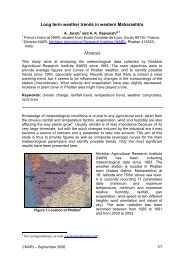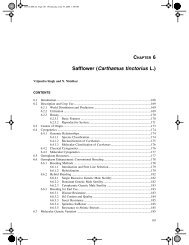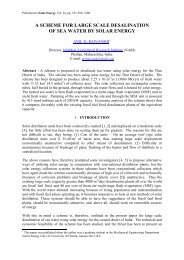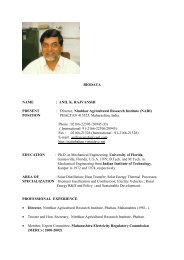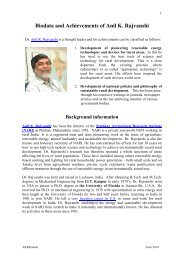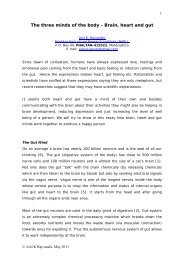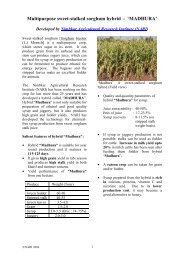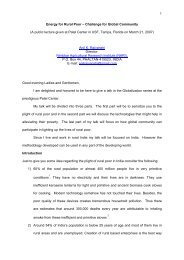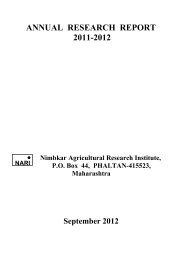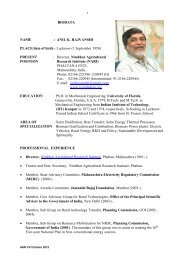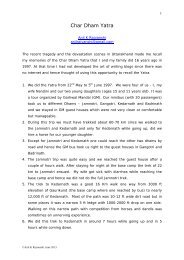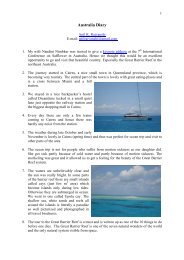Issues in safflower production in India - Australian Oilseeds Federation
Issues in safflower production in India - Australian Oilseeds Federation
Issues in safflower production in India - Australian Oilseeds Federation
You also want an ePaper? Increase the reach of your titles
YUMPU automatically turns print PDFs into web optimized ePapers that Google loves.
<strong>Issues</strong> <strong>in</strong> <strong>safflower</strong> <strong>production</strong> <strong>in</strong> <strong>India</strong>Nand<strong>in</strong>i NimbkarNimbkar Agricultural Research Institute (NARI), Lonand Road,Phaltan 415523, Maharashtra, <strong>India</strong>. nnimbkar@gmail.comAbstractBased on research carried out <strong>in</strong> the Nimbkar Agricultural Research Institute (NARI), elsewhere<strong>in</strong> <strong>India</strong> and around the world some important issues for <strong>production</strong> of <strong>safflower</strong> <strong>in</strong> <strong>India</strong> havebeen discussed. It is concluded that <strong>safflower</strong> can rega<strong>in</strong> its popularity if its exact niche isidentified and its flowers are exploited to the fullest extent.Key words: Safflower <strong>production</strong>-<strong>India</strong>-Economics-FlowersIntroduction<strong>India</strong> occupies premier position <strong>in</strong> <strong>safflower</strong> <strong>in</strong> the world as it was cultivated over an area of 364thousand hectares (50% of world area) and had a <strong>production</strong> of 229 thousand tons (27% ofworld <strong>production</strong>) dur<strong>in</strong>g 2005-06 (Anonymous, 2007). However, after atta<strong>in</strong>ment of the peakarea <strong>in</strong> 1988 (69% of world area) and peak <strong>production</strong> <strong>in</strong> 1994 (69% of world <strong>production</strong>), thearea and <strong>production</strong> have been <strong>in</strong> cont<strong>in</strong>uous decl<strong>in</strong>e (Figure 1). This decl<strong>in</strong>e has beenattributed to many different reasons. However the recent world trends especially for yield of<strong>safflower</strong> are somewhat rosier (Figure 2). This has ma<strong>in</strong>ly been due to 2503 kg/ha averageyield registered <strong>in</strong> Mexico <strong>in</strong> 2003, which was an <strong>in</strong>crease of nearly 150% over the previousyear. Even the peak average seed yields of 660 Kg/ha <strong>in</strong> <strong>India</strong> were atta<strong>in</strong>ed <strong>in</strong> 2007.State of Maharashtra where NARI is located accounts for about 72% area and 69% of<strong>production</strong> of <strong>safflower</strong> <strong>in</strong> <strong>India</strong>. Here it is practically entirely raised under residual soil moisture.Some of the reasons given for decl<strong>in</strong>e <strong>in</strong> area and <strong>production</strong> of <strong>safflower</strong> <strong>in</strong> <strong>India</strong> are:(1) Higher remuneration than <strong>safflower</strong> obta<strong>in</strong>ed for compet<strong>in</strong>g crops like sorghum and gramover the years. The average of price obta<strong>in</strong>ed for <strong>safflower</strong> from 1991 to 2003 has beenless than Rs. 12,000 ton -1 , which was lower than that for any other oilseed 1 . For the firsttime this year a price greater than Rs. 20,000 ton -1 was obta<strong>in</strong>ed for <strong>safflower</strong> seed. Thissudden <strong>in</strong>crease may have been due to <strong>in</strong>creas<strong>in</strong>g demand for oilseeds as a biodieselfeedstock.(2) Low oil content of 30% or less. All other oilseeds have an oil content of 40-60%.(3) Susceptibility to various biotic and abiotic stresses such as aphids (Uroleuconcompositae Theobold), wilt caused by Fusarium oxysporum f. sp. carthami, moisturestress and low nutrients.(4) Import of cheap palm oil.Economics of grow<strong>in</strong>g <strong>safflower</strong>From 2000-01 to 2007-08 the cost of grow<strong>in</strong>g <strong>safflower</strong> was calculated on NARI’s researchfarm tak<strong>in</strong>g the recommended package of practices as a guide and us<strong>in</strong>g the actual price of<strong>in</strong>puts <strong>in</strong> a given year. The cost was found to have <strong>in</strong>creased by 24% dur<strong>in</strong>g this period, whilethe market price obta<strong>in</strong>ed <strong>in</strong>creased by 100% i.e. doubled dur<strong>in</strong>g the 8-year period (Table 1).The highest cultivation cost <strong>in</strong>crease of 12% took place between the years 2001-02 and 2002-03, while the highest market price <strong>in</strong>crease of 33% took place between 2006-07 and 2007-08.In fact a 24% decl<strong>in</strong>e <strong>in</strong> market price was registered from 2003-04 to 2004-05, but the marketprice recovered to the earlier level <strong>in</strong> 2005-06. When the yield required for breakeven (i.e. noprofit no loss) was compared with actual yields obta<strong>in</strong>ed <strong>in</strong> a given year, only <strong>in</strong> years 2001-02and 2003-04 was it found to have dropped below the economical level.1 Rs. 40 = $ 1 U.S.
Table 1 : Economics of <strong>safflower</strong>Year Actual cost of<strong>production</strong>(Rs.)Highest marketprice obta<strong>in</strong>ed(Rs./kg)Yield requiredfor breakeven (Kg/ha)Actualyieldobta<strong>in</strong>ed(Kg/ha)Benefit-to- costratio2000-01 20295 11.0 1845 2109*** 1.142001-02 20833 11.77 1770 1106*** 0.622002-03 23245 14.0 1660 1789** 1.082003-04 23284 16.43 1417 1365* 0.962004-05 23736 12.45 1906 2090* 1.102005-06 23713 15.46 1534 2433* 1.592006-07 24232 16.53 1441 2779* 1.92007-08 25126 22.0 1142 1847* 1.62% <strong>in</strong>crease <strong>in</strong> 24 100 - - -8 years* Yield maximization trial ** Integrated nutrient *** Production potential under high(Variety : NARI-NH-1) management trial <strong>in</strong>put conditions(Variety : NARI-NH-1) (Variety : Bhima)Rs. 40 = $ 1 U.S.When cost of <strong>production</strong> was broken down <strong>in</strong>to its components about 50% was found to becontributed equally by land preparation, pesticides and bird watch<strong>in</strong>g. In the rema<strong>in</strong><strong>in</strong>g 50%,weed<strong>in</strong>g and th<strong>in</strong>n<strong>in</strong>g had a 14% and harvest<strong>in</strong>g and thresh<strong>in</strong>g a 10% share. The biggestcontributors to the cost of cultivation <strong>in</strong>crease over last eight years have been operations suchas sow<strong>in</strong>g, weed<strong>in</strong>g, th<strong>in</strong>n<strong>in</strong>g and bird watch<strong>in</strong>g which registered more than 40% <strong>in</strong>creasema<strong>in</strong>ly due to the rise of 50-55% <strong>in</strong> wages paid to the labourers. The bird watch<strong>in</strong>g operationhas become essential due to the use of non-sp<strong>in</strong>y cultivars which are more susceptible to birdpredation. Thus potentially there is a place for <strong>in</strong>creased mechanization of various operationsand <strong>in</strong>creased use of herbicides at least <strong>in</strong> irrigated <strong>safflower</strong> which has generally higher levelsof seed yield. Many farmers around Phaltan have successfully used wheat comb<strong>in</strong>es toharvest their <strong>safflower</strong>.Earlier <strong>in</strong> 1992-93 and 1993-94 when the preemergence herbicides Pendimethal<strong>in</strong>, Fluchloral<strong>in</strong>and Oxadiazon were compared with hand weed<strong>in</strong>g and <strong>in</strong>terculture with hoes, the surpris<strong>in</strong>gconclusion was that not only were there no statistically significant differences for seed yieldbetween these different methods of weed control, but unweeded control also gave seed yieldson par with those where weed control methods were employed. Thus it appears that therecommended two weed<strong>in</strong>gs may not be necessary and only one weed<strong>in</strong>g is probablyadequate even under irrigated conditions.Until recently economics of irrigated high-<strong>in</strong>put <strong>safflower</strong> did not look so good, especially fornon-sp<strong>in</strong>y cultivars. However, the ma<strong>in</strong> reason for develop<strong>in</strong>g non-sp<strong>in</strong>y hybrids was to enablethe pick<strong>in</strong>g of flowers with ease <strong>in</strong> addition to encourag<strong>in</strong>g the spread of <strong>safflower</strong> <strong>in</strong> nontraditionalareas. Therefore, if the flower component is added then the economics of <strong>safflower</strong>looks really good.Safflower flowersAbout 10 years ago we at NARI felt that one of the quickest ways to revive farmers’ <strong>in</strong>terest <strong>in</strong><strong>safflower</strong> would be to exploit the <strong>safflower</strong> flowers which have been traditionally used <strong>in</strong> <strong>India</strong>for dye<strong>in</strong>g cloth. With the grow<strong>in</strong>g demand for vegetable dyes <strong>in</strong>ternationally, not only fordye<strong>in</strong>g cloth but also as a food colour<strong>in</strong>g this was a promis<strong>in</strong>g avenue to be explored. Aftersome <strong>in</strong>vestigation we became aware of its use <strong>in</strong> Ch<strong>in</strong>a as a herbal medic<strong>in</strong>e for cur<strong>in</strong>gseveral chronic diseases such as hypertension, problems of blood circulation and coronaryailments (Dajue and Mundel, 1996). NARI has been test-market<strong>in</strong>g these flowers as ‘herbal tea’for last several years. They fetch about Rs. 400 kg -1 as opposed to Rs. 20 kg -1 obta<strong>in</strong>ed forseed. The average flower yield is about 100 kg ha -1 and even consider<strong>in</strong>g average seed yield of1000 kg ha -1 potentially at least twice the <strong>in</strong>come as that from seed can be obta<strong>in</strong>ed.
S<strong>in</strong>ce a majority of <strong>safflower</strong> varieties grown <strong>in</strong> <strong>India</strong> were sp<strong>in</strong>y, collect<strong>in</strong>g flowers from themwas tedious, time-consum<strong>in</strong>g and labour-<strong>in</strong>tensive. Therefore, both battery and spark ignitioneng<strong>in</strong>e-powered flower collectors were developed at NARI (Rajvanshi, 2005). However, withthe national release of non-sp<strong>in</strong>y variety NARI-6 and hybrid NARI-NH-1, it is now possible <strong>in</strong><strong>India</strong> to collect flowers economically by hand without the help of a mach<strong>in</strong>e.In order to maximize both flower and seed yields <strong>in</strong> <strong>safflower</strong>, an agronomic experiment wascarried out on the non-sp<strong>in</strong>y hybrid NARI-NH-1 for three years. It was <strong>in</strong> a split-split plot designwith three replications. The treatments are given <strong>in</strong> Table 2.Table 2 : Treatments <strong>in</strong> trial for maximization of seed and flower yields <strong>in</strong> <strong>safflower</strong> (2002-04)Treatments Dates of sow<strong>in</strong>g (Ma<strong>in</strong>) Levels of fertilizer (Sub) Spac<strong>in</strong>gs (Sub-sub)1 October 3 No fertilizer 45 X 10 cm2 October 18 50% recommended dose 45 X 20 cm3 November 1 100% recommended dose 45 X 30 cm4 150% recommended dose 60 X 10 cm5 60 X 20 cm6 60 X 30 cmRecommended dose :60 N : 30 P 2 O 5 :30 K 2 OSow<strong>in</strong>g 15 and 27 days after October 3 caused a reduction of 8 and 22% <strong>in</strong> flower yield and 18and 38% <strong>in</strong> seed yield respectively. Thus seed yield was affected more than flower yield. Thema<strong>in</strong> yield component affected was capitulum number (25 and 21% reduction) followed bynumber of seeds per capitulum (8 and 22% reduction) and 100-seed weight (5 and 12%reduction). Surpris<strong>in</strong>gly, height of plants was seen to <strong>in</strong>crease by 13 and 26% respectively by a15 and 27-day delay <strong>in</strong> plant<strong>in</strong>g.Though one would th<strong>in</strong>k that date of plant<strong>in</strong>g should be the easiest recommendation to adhereto as it does not cost anyth<strong>in</strong>g to follow, our experience has shown otherwise. The ma<strong>in</strong>problems encountered have been:(1) Inability to prepare the land for plant<strong>in</strong>g of <strong>safflower</strong> <strong>in</strong> time after the harvest of ra<strong>in</strong>y seasoncrops like sorghum or soybean, either due to its their delayed sow<strong>in</strong>g or lack of proper soilconditions for land preparation because of cont<strong>in</strong>uous ra<strong>in</strong>fall. If farmers adopt no-tillfarm<strong>in</strong>g then this problem may be solved.(2) Propensity of the farmers to wait and watch how much ra<strong>in</strong>fall takes place. If ra<strong>in</strong>fallappears to be adequate they prefer to sow other crops like fodder sorghum, gram,sunflower or wheat especially if supplemental irrigation is available. By the time the ra<strong>in</strong>sstop, it is usually early to mid-November when the farmers f<strong>in</strong>ally come around to plant<strong>in</strong>g<strong>safflower</strong> if at all. This results <strong>in</strong> 30-40% reduction <strong>in</strong> expected seed yields.Further the results of the flower and seed yield maximization trial showed that with a 50%reduction <strong>in</strong> recommended fertilizer dosages, both flower and seed yields were reduced byabout 7% with net returns be<strong>in</strong>g reduced by 9%. This was ma<strong>in</strong>ly due to about 8% reduction <strong>in</strong>number of capitula per plant. Without any fertilizer the flower and seed yields were reduced byabout 19% and net returns by 26%. This was also ma<strong>in</strong>ly due to nearly 17% reduction <strong>in</strong>number of capitula per plant. It was not worthwhile to apply 150% of recommended fertilizerdosage as it caused only a 3 and 4% <strong>in</strong>crease <strong>in</strong> flower and seed yield respectively with about3% <strong>in</strong>crease <strong>in</strong> net returns.Among the spac<strong>in</strong>gs tested only 45 X 10 cm gave an <strong>in</strong>crease of 10% <strong>in</strong> flower yield and 11%<strong>in</strong> seed yield over the recommended spac<strong>in</strong>g of 45 X 20 cm. This appears to be ma<strong>in</strong>ly due to<strong>in</strong>crease <strong>in</strong> f<strong>in</strong>al plant stand by about 71% though 100-seed weight also <strong>in</strong>creased by about5%. All other spac<strong>in</strong>gs tested gave a 5 to 22% reduction <strong>in</strong> flower yield and 7 to 25% reduction<strong>in</strong> seed yield as compared to 45 X 20 cm spac<strong>in</strong>g. Thus the optimum plant population is about100,000 plants per hectare.
The results thus suggest that sow<strong>in</strong>g of <strong>safflower</strong> <strong>in</strong> the first week of October with a spac<strong>in</strong>g of45 X 20 cm and application of 60:30:30 kg N:P 2 O 5 :K 2 O per hectare can be recommended forobta<strong>in</strong><strong>in</strong>g maximum seed and flower yields from non-sp<strong>in</strong>y <strong>safflower</strong> hybrid NARI-NH-1.IrrigationIn most countries, irrigated agriculture accounts for most freshwater use (as much as 70-80%),far higher than dr<strong>in</strong>k<strong>in</strong>g water and domestic consumption (Hightower and Pierce, 2008).Increas<strong>in</strong>g pressures to reduce the share of water available to agriculture along with theforecasted uncerta<strong>in</strong> climate <strong>in</strong> near future is expected to <strong>in</strong>crease the importance of crops like<strong>safflower</strong>, which has a reputation of be<strong>in</strong>g a drought-resistant crop. This is ma<strong>in</strong>ly based on itsability to withdraw water from a depth of up to 3.5 m (Anonymous, 2002). Because it canexplore a large, deep soil volume to recover water it is able to grow when other crops with lessaggressive root systems cannot (Kaffka and Kearney, 1998).It is said that <strong>in</strong> deep soils with high water hold<strong>in</strong>g capacity such as Chromusterts (vertisols orheavy crack<strong>in</strong>g clays) at our location, usually two to three irrigation applications dur<strong>in</strong>g theseason are sufficient for <strong>safflower</strong>. However, the number of irrigations is not what is important,but the quantity of water which is applied. It has been our observation that <strong>in</strong> <strong>safflower</strong> due tothe longer <strong>in</strong>terval between two irrigations (30-35 days) and its ability of exhaust water from thesoil profile to a greater depth, it takes at least twice as long to irrigate the same area under<strong>safflower</strong> as compared to other w<strong>in</strong>ter crops like wheat, sorghum, sunflower, gram etc.Thus <strong>safflower</strong> will survive and produce a low yield if it can transpire a m<strong>in</strong>imum of 400-460 mmof water (Kaffka and Kearney, 1998), but to grow and produce an economic yield (approx. 2T.ha -1 ) nearly the same amount of water is required per unit of dry matter produced as requiredby other C 3 crops under comparable conditions. This was also seen <strong>in</strong> a study by Merrill et al.(2001) who measured water use by 10 crops <strong>in</strong> the Northern Great Pla<strong>in</strong>s. Sunflower was thegreatest water user with <strong>safflower</strong> the second greatest. This observation was attributed to thedeepest taproot-organized root system of <strong>safflower</strong> and its capability of extract<strong>in</strong>g subsoil waterat greater depths than all other crops studied. For this reason world over <strong>safflower</strong> has beenfound to be very effective <strong>in</strong> lower<strong>in</strong>g water table where dra<strong>in</strong>age is required.Frontl<strong>in</strong>e demonstration on farmers’ fields <strong>in</strong> major <strong>safflower</strong> grow<strong>in</strong>g regions of <strong>India</strong> <strong>in</strong>dicatedthe possibility of enhanc<strong>in</strong>g <strong>safflower</strong> yields by 43-69% under ra<strong>in</strong>fed conditions by adopt<strong>in</strong>g thewhole package which <strong>in</strong>cluded improved varieties, th<strong>in</strong>n<strong>in</strong>g, fertilizer, irrigation, plant protectionetc. Table 3 shows that irrigation consistently gave an improvement of 45% <strong>in</strong> productivity.On the other hand, <strong>safflower</strong> is particularly susceptible to excess moisture either as ra<strong>in</strong>,stand<strong>in</strong>g water or high humidity because of its susceptibility to various fungal diseases undersuch conditions. Excessive ra<strong>in</strong> at flower<strong>in</strong>g can also affect poll<strong>in</strong>ation adversely prevent<strong>in</strong>gproper seed fill<strong>in</strong>g. Zimmerman (1978) noted that there can be an <strong>in</strong>teraction between hightemperature and high humidity, which can severely reduce seed yield. At our location maximumseed yields are produced when <strong>safflower</strong> is irrigated at elongation and/or pre-flower<strong>in</strong>g.Irrigation after flower<strong>in</strong>g generally has disastrous consequences due to <strong>in</strong>creased disease<strong>in</strong>cidence.
Table 3 : Productivity improvement (%) <strong>in</strong> <strong>safflower</strong> through different <strong>in</strong>terventionsIntervention Improvement (%)Whole package 43-69Improved varieties 13-48Th<strong>in</strong>n<strong>in</strong>g 6-15Fertilizer 27-68Irrigation 45Plant protection 14-56Growth regulator (Cycocel) 19Anonymous. 2004. Project Director’s Report (2003-04). All <strong>India</strong> Coord<strong>in</strong>ated ResearchProject on Safflower. Directorate of <strong>Oilseeds</strong> Research (<strong>India</strong>n Council of AgriculturalResearch), Rajendranagar, Hyderabad-500030. 17 pp.Fertilizer applicationAs for any other crop, fertilizer amounts required for <strong>safflower</strong> depend on the yields desired, theplace of <strong>safflower</strong> <strong>in</strong> a rotation and the other crops <strong>in</strong>cluded, as well as on the soil type used.At our location the soils generally have a normal pH (7.4-8.5) and electrical conductivity (0.10-1.24 mmhos.cm -3 ), medium to high nitrogen (153-335 kg ha -1 ), very low to adequatephosphorus (13-60 kg ha -1 ) and very high potassium (403-645 kg ha -1 ).The different treatments <strong>in</strong> trials conducted on (1) Phosphorus management <strong>in</strong> <strong>safflower</strong>-basedcropp<strong>in</strong>g system and (2) Integrated nutrient management <strong>in</strong> <strong>safflower</strong>-based cropp<strong>in</strong>g system <strong>in</strong>last seven and six years respectively are given <strong>in</strong> Table 4. The pooled analysis of these datagave non-significant differences between the treatments for seed yield and net returns.However, <strong>in</strong>dividual years did show some significant results. In all the years when significantdifferences were obta<strong>in</strong>ed, 100% P to soybean and 5 T farmyard manure (FYM) ha -1 +Phosphorus Solubiliz<strong>in</strong>g Bacteria (PSB) to <strong>safflower</strong> gave the significantly highest seed yieldsof <strong>safflower</strong>. In three out of four years the treatments of 50% P + PSB to both soybean and<strong>safflower</strong> and 5 T FYM.ha -1 to soybean and 100% P to <strong>safflower</strong> or vice versa gave thesignificantly highest <strong>safflower</strong> seed yields.Table 4 : Treatments <strong>in</strong> fertilizer trialsSr. Trial 1 : Phosphorus management <strong>in</strong>No.<strong>safflower</strong>-based cropp<strong>in</strong>gsystemTrial 2 : Integrated nutrient management <strong>in</strong> <strong>safflower</strong>basedcropp<strong>in</strong>g system(2001-07) (2002-07)Soybean Safflower Soybean Safflower1. No P No P No NP No NP2. 100% P 100% P 50% NP 50% NP3. 50% P 100% P 50% NP 100% NP4. 50% P 50% P 100% NP 50% NP5. 50% P + PSB 50% P + PSB 100% NP 100% NP6. No P 100% P 100% NP 50% N + 100% P7. 5 T FYM/ha 100% P 100% NP Azoto./Azospi. + 100% P8. 5 T FYM/ha + PSB 100% P 100% NP 50% N + Azoto. / Azospi. +100% P9. 100% P 50% P 100% NP Azoto./Azospi. + PSB10. 100% P No P 100% NP 50% NP + Azoto. / Azospi.+ PSB11. 100% P 5 T FYM/ha 100% N + 50% P + PSB 100% NP12. 100% P 5 T FYM/ha +PSB100% N + 50% P + PSB 50% NP + Azoto. / Azospi.+ PSBPSB = Phosphorus-solubiliz<strong>in</strong>g bacteria Azoto. = Azotobacter. Azospi. = Azospirillum
In the <strong>in</strong>tegrated nutrient management trial, <strong>in</strong> all the years 100% NP to both soybean and<strong>safflower</strong> gave the significantly highest seed yield and net returns, while <strong>in</strong> five out of six years50% NP or 100% N + 50% P + PSB to soybean and 100% NP to <strong>safflower</strong> gave significantlyhighest seed yields and net returns for <strong>safflower</strong>. Only <strong>in</strong> one or two years was it possible tosubstitute a part of fertilizer N by seed treatment with Azotobacter and Azospirillum withoutsignificant adverse effect on productivity.In the trial conducted to assess response of <strong>safflower</strong> to micronutrients there were nostatistically significant differences for seed yield between the different dosages of ZnSO 4 ,FeSO 4 and elemental sulphur tested <strong>in</strong> any of the five years when the trial was conducted.Similarly <strong>in</strong> a trial for test<strong>in</strong>g the effect of different sources of sulphur [(NH 4 ) 2 SO 4 , s<strong>in</strong>gle superphosphate (SSP), elemental sulphur and gypsum)] to supply 15, 30 and 45 Kg sulphur. ha -1 , nostatistically significant differences were found between the treatments <strong>in</strong> the pooled analysis ofthree years’ data. However, <strong>in</strong> two out of three years SSP to supply 15 Kg sulphur.ha -1 gavethe significantly highest seed yield and net returns.In another trial, <strong>production</strong> potential of <strong>safflower</strong> variety Bhima was tested for two years (2000-01 and 2001-02) under high <strong>in</strong>put conditions. In this trial 100 and 150% recommended fertilizerdoses were applied with or without FYM (10 T.ha -1 ) and sulphur (40 Kg.ha -1 ). Differencesbetween the treatments for seed yield and other parameters were non-significant. Significantlyhighest benefit: cost ratios were given by 100 and 150% recommended fertilizer applicationwith or without sulphur and without FYM. Prices of FYM are generally quite high and itsavailability has also been reduced drastically <strong>in</strong> recent years. There has been a 600% <strong>in</strong>crease<strong>in</strong> the price of FYM <strong>in</strong> last 18 years (from Rs. 200 to Rs. 1400 T -1 ). Also with the cost of load<strong>in</strong>gand unload<strong>in</strong>g and transport the price at present can be as much as Rs. 1800 T -1 of FYM.Improved varietiesSeed is the lowest-value <strong>in</strong>put and till recently most farmers tended to save their own seed fromthe previous year. Even the relatively costlier seed of hybrids contributes a maximum of 5-6%to the total cultivation cost.NARI has nationally released two sp<strong>in</strong>y varieties, and one each non-sp<strong>in</strong>y variety, non-sp<strong>in</strong>yhybrid and sp<strong>in</strong>y hybrid <strong>in</strong> last 20 years. Their performance is listed <strong>in</strong> Table 5.Table 5 : Performance of released <strong>safflower</strong> varieties and hybrids developed at NARI <strong>in</strong>comparison with the checks.Sr.No.Variety/hybrid(Year ofrelease)Seedyield(Kg/ha)%<strong>in</strong>creaseovercheckOilyield(kg/ha)%<strong>in</strong>creaseovercheckFloweryield(kg/ha)%<strong>in</strong>creaseovercheckImportantcharacteristics1. Nira (1987) 2012 19.90 654 32.1 - - Sp<strong>in</strong>y, early-matur<strong>in</strong>gaphid-tolerant variety2. NARI-6(2000)1024 20.19 304 25.97 73.0 - 5.49 Non-sp<strong>in</strong>y variety withdark red flowers3. NARI-NH-1(2001)1895 24.83 593 32.96 215 128.72 Non-sp<strong>in</strong>y, moderatelypest and disease4. NARI-H-15(2005)tolerant hybrid2201 18.65 669 14.33 - - Sp<strong>in</strong>y, moderatelypest and diseasetoleranthybrid5. NARI-38(2007)Check for 2 and 3 : non-sp<strong>in</strong>y variety JSI-7Check for 1 and 5 : sp<strong>in</strong>y variety A-1 (national check)Check for 4 : non-sp<strong>in</strong>y hybrid NARI-NH-12038 9.46 534 15.43 - - Sp<strong>in</strong>y, moderatelywilt-resistant variety
Plant protectionAll our breed<strong>in</strong>g material is screened for aphid (Uroleucon compositae Theobold) tolerance, butvery little work on entomology of <strong>safflower</strong> has been carried out at NARI <strong>in</strong> recent years. Oneof the major reasons for low productivity of <strong>safflower</strong> <strong>in</strong> <strong>India</strong> is <strong>in</strong>festation of aphids withestimates of yield loss as high as 74% (Bhardwaj et al., 1990). No resistance to this pest hasbeen identified so far.S<strong>in</strong>ce under irrigated conditions diseases assume much more importance <strong>in</strong> <strong>safflower</strong> thanwhen it is grown as a ra<strong>in</strong>fed crop, we have a fairly active pathology program. Dur<strong>in</strong>g the pastyear we screened all the treatments <strong>in</strong> the <strong>in</strong>tegrated nutrient management trial (mentionedearlier <strong>in</strong> the section on fertilizer application) aga<strong>in</strong>st foliar diseases (ma<strong>in</strong>ly Alternaria). All thethree treatments <strong>in</strong> which 100% NP application was given to <strong>safflower</strong> showed significantlyhigher Alternaria disease score than the other treatments. Thus application of <strong>in</strong>organicfertilizers appears to <strong>in</strong>crease susceptibility of <strong>safflower</strong> to foliar diseases.In 2007-08 <strong>in</strong> a trial for fungicidal management of Alternaria leaf spot when Plant DiseaseIntensity (PDI) at 100 days after sow<strong>in</strong>g (DAS) was 38, not only did none of the eight differentfungicides used give any statistically significant differences <strong>in</strong> seed yield and net returns, butthe water-sprayed control was on par with them. However, <strong>in</strong> 2006-07 when the PDI at 100DAS was 64, treatments with either Carbendazim (0.1%) or Difenconazole (0.05%) gavesignificantly higher seed yield than the other treatments. This underscores the importance ofdeterm<strong>in</strong><strong>in</strong>g the threshold values for undertak<strong>in</strong>g plant protection measures.In laboratory and pot studies conducted at NARI dur<strong>in</strong>g last two years coat<strong>in</strong>g of seeds withantagonists of Macrophom<strong>in</strong>a phaseol<strong>in</strong>a viz. Trichoderma viride, T. harzianum, Bacillussubtilis and Pseudomonas fluorescens was found to effectively combat <strong>safflower</strong> root rot.Elsewhere <strong>in</strong> <strong>India</strong> T. harzianum @ 10 g/kg seed has been found to be effective <strong>in</strong>management of <strong>safflower</strong> wilt.ConclusionsUnder the present situation of available varieties, achievable yield potential and price structureit does not appear that <strong>safflower</strong> can be a very popular crop <strong>in</strong> <strong>India</strong> under high-<strong>in</strong>putconditions. It can however be grown profitably under ra<strong>in</strong>fed conditions and by apply<strong>in</strong>gselected low-value <strong>in</strong>puts. It will be very important to identify its exact niche, if its cont<strong>in</strong>uousdecl<strong>in</strong>e <strong>in</strong> <strong>India</strong> and may be <strong>in</strong> the world is to be reversed. Eckhoff et al. (2005) concluded after14 years’ of study that with adequate weed control, organic <strong>safflower</strong> can be produced withoutapplication of fertilizers or pesticides with little or no loss of seed yield, oil yield or quality. I feel<strong>safflower</strong> community needs to take a serious note of such studies and carry out furtherresearch to validate these results under varied conditions.Exploitation of <strong>safflower</strong> flowers as a source of pigment and for medic<strong>in</strong>al and nutritional usesmay be the key <strong>in</strong>tervention required to <strong>in</strong>crease the popularity of this crop <strong>in</strong> the world and forrestor<strong>in</strong>g its status as an important oilseed crop.AcknowledgementsI wish to thank Dr. Vrijendra S<strong>in</strong>gh, Mr. M. B. Deshpande and Mr. S. V. Choudhari for theirassistance <strong>in</strong> preparation of this paper. F<strong>in</strong>ancial support from the <strong>India</strong>n Council of AgriculturalResearch, New Delhi for research on <strong>safflower</strong> at NARI for more than 30 years is gratefullyacknowledged.
ReferencesAnonymous. 2002. Safflower. Crop Water Management. AGLW Water Management Group.Land and Water Development Division (www.fao.org/ag/AGL/aglw/cropwater/<strong>safflower</strong>.stm).Anonymous. 2007. Project Directors’ Report. Annual Research Workers’ Group Meet<strong>in</strong>g ofSafflower. Aug. 23-25, 2007. Maharana Pratap Univ. of Agriculture & Technology,Udaipur. Directorate of <strong>Oilseeds</strong> Research, Rajendranagar, Hyderabad-500030.Bhardwaj, S. C., Kumar, A., Bhargava, G. K. and Rana, B. S. 1990. Assessment of lossescaused by <strong>in</strong>sect pests <strong>in</strong> <strong>safflower</strong> (Carthamus t<strong>in</strong>ctorius L.). <strong>India</strong>n J. Appl. Ent. 4 : 61-70.Dajue, Li and Mundel, H. H. 1996. Safflower Carthamus t<strong>in</strong>ctorius L. Promot<strong>in</strong>g theconservation and use of underutilized and neglected crops. 7. Institute of Plant Geneticsand Crop Plant Research, Gatersleben/International Plant Genetic Resources Institute,Rome, Italy. 83 pp.Eckhoff J., Bergman, J. and Flynn C. 2005. A comparison of <strong>safflower</strong> (Carthamus t<strong>in</strong>ctoriusL.) grown under conventional and chemical-free conditions. P. 100-103. In : Proceed<strong>in</strong>gsof VIth International Safflower Conference, Istanbul, Turkey, 6-10 June, 2005.Hightower, M. and Pierce S. A. 2008. The energy challenge (Commentary).Nature. 452 : 285-86. 20 March 2008.Kaffka, S. R. and Kearney, T. E. 1998. Safflower Production <strong>in</strong> California. UC Agriculture andNatural Resources Publication 21565 (http://agric.ucdavis.edu/crops/oilseed/saff5water.htm).Merrill, S. D., Tanaka, D. L., Krup<strong>in</strong>sky, J. M. and Ries, R. E. 2001. Safflower root growth andwater use <strong>in</strong> comparison with other crops. P. 227-231. In : Proceed<strong>in</strong>gs of VthInternational Safflower Conference, Williston, N.D., U.S.A., 23-27 July, 2001.Rajvanshi, A. K. 2005. Development of <strong>safflower</strong> petal collector. P. 80-85. In : Proceed<strong>in</strong>gsof VIth International Safflower Conference, Istanbul, Turkey, 6-10 June 2005.Zimmerman, L. H. 1978. Selection of <strong>safflower</strong> for tolerance to temperature and humiditystress dur<strong>in</strong>g flower<strong>in</strong>g. Crop Sci. 18 (5) : 755-757.
Figure 1Damodaram, T. and Hegde, D. M. (2005). <strong>Oilseeds</strong> situation : A statistical compendium 2005.Directorate of <strong>Oilseeds</strong> Research, Hyderabad.Figure 2Damodaram, T. and Hegde, D. M. (2005). <strong>Oilseeds</strong> situation : A statistical compendium 2005.Directorate of <strong>Oilseeds</strong> Research, Hyderabad.



